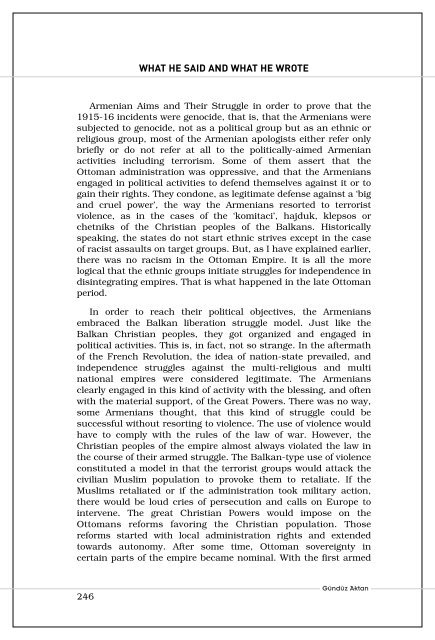gunduz-aktan-kitap-soyledikleri-ve-yazdiklari
gunduz-aktan-kitap-soyledikleri-ve-yazdiklari
gunduz-aktan-kitap-soyledikleri-ve-yazdiklari
Create successful ePaper yourself
Turn your PDF publications into a flip-book with our unique Google optimized e-Paper software.
WHAT HE SAID AND WHAT HE WROTE<br />
Armenian Aims and Their Struggle in order to pro<strong>ve</strong> that the<br />
1915-16 incidents were genocide, that is, that the Armenians were<br />
subjected to genocide, not as a political group but as an ethnic or<br />
religious group, most of the Armenian apologists either refer only<br />
briefly or do not refer at all to the politically-aimed Armenian<br />
activities including terrorism. Some of them assert that the<br />
Ottoman administration was oppressi<strong>ve</strong>, and that the Armenians<br />
engaged in political activities to defend themsel<strong>ve</strong>s against it or to<br />
gain their rights. They condone, as legitimate defense against a ‘big<br />
and cruel power’, the way the Armenians resorted to terrorist<br />
violence, as in the cases of the ‘komitaci’, hajduk, klepsos or<br />
chetniks of the Christian peoples of the Balkans. Historically<br />
speaking, the states do not start ethnic stri<strong>ve</strong>s except in the case<br />
of racist assaults on target groups. But, as I ha<strong>ve</strong> explained earlier,<br />
there was no racism in the Ottoman Empire. It is all the more<br />
logical that the ethnic groups initiate struggles for independence in<br />
disintegrating empires. That is what happened in the late Ottoman<br />
period.<br />
In order to reach their political objecti<strong>ve</strong>s, the Armenians<br />
embraced the Balkan liberation struggle model. Just like the<br />
Balkan Christian peoples, they got organized and engaged in<br />
political activities. This is, in fact, not so strange. In the aftermath<br />
of the French Revolution, the idea of nation-state prevailed, and<br />
independence struggles against the multi-religious and multi<br />
national empires were considered legitimate. The Armenians<br />
clearly engaged in this kind of activity with the blessing, and often<br />
with the material support, of the Great Powers. There was no way,<br />
some Armenians thought, that this kind of struggle could be<br />
successful without resorting to violence. The use of violence would<br />
ha<strong>ve</strong> to comply with the rules of the law of war. Howe<strong>ve</strong>r, the<br />
Christian peoples of the empire almost always violated the law in<br />
the course of their armed struggle. The Balkan-type use of violence<br />
constituted a model in that the terrorist groups would attack the<br />
civilian Muslim population to provoke them to retaliate. If the<br />
Muslims retaliated or if the administration took military action,<br />
there would be loud cries of persecution and calls on Europe to<br />
inter<strong>ve</strong>ne. The great Christian Powers would impose on the<br />
Ottomans reforms favoring the Christian population. Those<br />
reforms started with local administration rights and extended<br />
towards autonomy. After some time, Ottoman so<strong>ve</strong>reignty in<br />
certain parts of the empire became nominal. With the first armed<br />
246<br />
Gündüz Aktan



